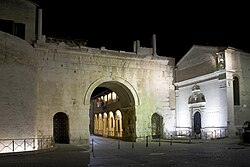Loading AI tools
Comune in Marche, Italy From Wikipedia, the free encyclopedia
Fano (Italian: [ˈfaːno]) is a town and comune of the province of Pesaro and Urbino in the Marche region of Italy. It is a beach resort 12 kilometres (7 miles) southeast of Pesaro, located where the Via Flaminia reaches the Adriatic Sea. It is the third city in the region by population after Ancona and Pesaro.
Fano | |
|---|---|
| Comune di Fano | |
 Arch of Augustus | |
 Fano within the Province of Pesaro-Urbino | |
| Coordinates: 43°50′33″N 13°0′49″E | |
| Country | Italy |
| Region | Marche |
| Province | Pesaro e Urbino (PU) |
| Frazioni | Bellocchi, Caminate, Carignano, Carrara di Fano, Centinarola, Cuccurano, Falcineto, Fenile, Magliano, Marotta, Metaurilia, Ponte Sasso, Roncosambaccio, Rosciano, Sant'Andrea in Villis, Torrette di Fano, Tre Ponti |
| Government | |
| • Mayor | Luca Serfilippi (Lega) |
| Area | |
| • Total | 121 km2 (47 sq mi) |
| Elevation | 12 m (39 ft) |
| Population (31 December 2017)[2] | |
| • Total | 60,978 |
| • Density | 500/km2 (1,300/sq mi) |
| Demonym | Fanesi |
| Time zone | UTC+1 (CET) |
| • Summer (DST) | UTC+2 (CEST) |
| Postal code | 61032 |
| Dialing code | 0721 |
| Patron saint | Saint Paternian |
| Saint day | 10 July |
| Website | Official website |
This section needs expansion. You can help by adding to it. (June 2008) |
An ancient town of Marche, it was known as Fanum Fortunae[3] after a temple of Fortuna located there. Its first mention in history dates from 49 BC, when Julius Caesar held it, along with Pisaurum and Ancona. Caesar Augustus established a colonia, and built a wall, some parts of which remain. In 2 AD Augustus also built an arch (which is still standing) at the entrance to the town.


In January 271, the Roman Army defeated the Alamanni in the Battle of Fano that took place on the banks of the Metauro river just inland of Fano.
Fano was destroyed by Vitiges' Ostrogoths in AD 538. It was rebuilt by the Byzantines, becoming the capital of the maritime Pentapolis ("Five Cities") that included also Rimini, Pesaro, Senigallia and Ancona. In 754 it was donated to the Holy See by the Frankish kings.
The Malatesta became lords of the city in 1356 with Galeotto I Malatesta, who was nominally only a vicar of the Popes. Among the others, Pandolfo III resided in the city. Under his son, the famous condottiero Sigismondo Pandolfo Malatesta, Fano was besieged by Papal troops under Federico III da Montefeltro, and returned to the Papal administration. It was later part of the short-lived state of Cesare Borgia, and then part of the duchy of the della Roveres in the Marche.
During the Napoleonic Wars it suffered heavy spoliations; the city had an active role in the Risorgimento. In World War I Fano was several times bombed by the Austro-Hungarian Navy. During World War II it was massively bombed by Allied aeroplanes due to hit the strategic railway and street bridges crossing the Metauro river. When the Nazis withdrew from the town they destroyed all of the bell towers in the town.
During the 1916 Rimini earthquakes, two spires of Fano Cathedral collapsed, a large stucco angel fell in the Church of Sant'Agostino, and part of the belltower wall of the Church of Santa Maria del Gonfalone collapsed. Part of a wall of the Church of San Paterniano collapsed.[4] The earthquake of 16 August caused an exodus from the town.[5]
Outside the city, in the place called Bellocchi, is the church of St. Sebastian (16th century), for the construction of which parts of the ancient cathedral were used.
The Ultimate Frisbee Fano Association was created in 2001. The association has 4 teams: Croccali (mixed), Mirine (women), Spaccamadoni (men) and Angry Gulls (juniors). Since 2001, the association has won 8 Italian championships.
Fano is twinned with:
Seamless Wikipedia browsing. On steroids.
Every time you click a link to Wikipedia, Wiktionary or Wikiquote in your browser's search results, it will show the modern Wikiwand interface.
Wikiwand extension is a five stars, simple, with minimum permission required to keep your browsing private, safe and transparent.